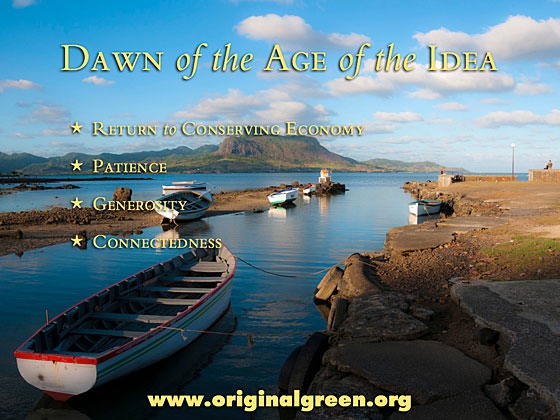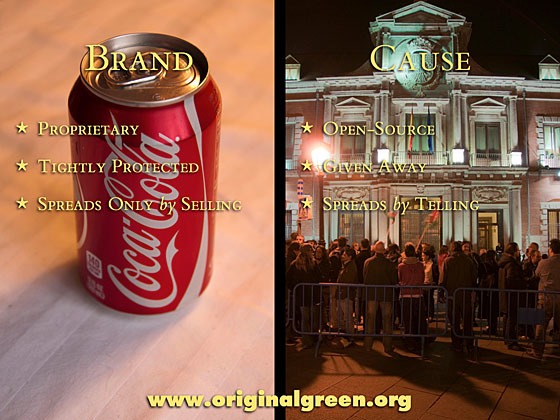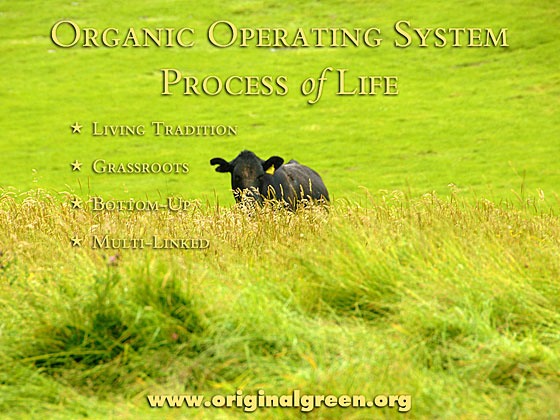Architecture in the Age of Austerity - 2
search the Original Green Blog

The Era of the Company was the time of the Consuming Economy, and it is now ending. Its three primary virtues were quality, speed, and economy... or better-faster-cheaper, if you prefer. Today, if you are an architect and all you have to offer is some combination of better, faster, and cheaper, you're likely not going to make it. This is an issue of survival. To be clear, it's not that companies won't continue... they will... but they're unlikely to be the centerpieces of our economic lives that they've been since the beginning of the Industrial Revolution.

The replacement for the Era of the Company is the Age of the Idea, which is now dawning. Its three primary virtues are likely to be patience, generosity, and connectedness, and it is likely to embody the return to a Conserving Economy.

Patience is, in many ways, the opposite to speed. In the Era of the Company, we were in a rush for everything, from fast food to speedy cars. But in the Age of the Idea, it takes time to get a following for your ideas.

Generosity is quite opposite to to economy. Practitioners in an age of austerity operating by the rules of a Consuming Economy could not imagine giving anything away. But today, a "teaser" is treated with the same respect as spam, which is complete disdain. Unless you're willing to give things away that are useful on their own, with no expectation that the recipients will come back to you for other things, you haven't discovered true generosity. But when you do, you will get far more in return than you ever would have gotten if you protected all your material.

Connectedness is curious, because while it's not the opposite to quality, it does sit at the opposite end of the timeline. In the Era of the Company, you began by producing high-quality work. That high-quality work led to many connections with people that wanted to know about you. But it could lead to arrogance because of the hubris that comes with making it on your own. In the Age of the Idea one starts at the other end. I founded the New Urban Guild over a decade ago, four members of which are in today's audience, and the members of the Guild tend to make each other better. I have seen many improvements in my own work, for example, because of the Guild members I have worked with. When you realize that your own improvements are due to the skills of others, that realization leads to humility instead of arrogance.

The transfer mechanism of the Era of the Company was the brand. A brand is highly proprietary. If someone infringes upon your brand, you protect it vigorously by calling in the lawyers. A brand only spreads by selling... if you quit selling, the brand quits spreading. A cause, on the other hand, is the preferred transfer mechanism of the Age of the Idea. Unlike a brand, a cause is open-source, and it is given away. And it is spread by telling, not selling. So a cause you create can take on a life of its own and spread to people you will never meet, and those that live far beyond your lifespan.

The Era of the Company operated on a mechanical paradigm... as a matter of fact, the mechanical paradigm opened the Era of the Company at the beginning of the Industrial Revolution. The mechanical paradigm needs a Consuming Economy to generate more customers for more products, in order to keep the machines running at increasing rates.

The operating system of the mechanical paradigm is the command & control system. It is top-down, hierarchical, and linear along the chain of command.

The Age of the Idea, I believe, will operate instead by the organic paradigm. The organic paradigm is the highest expression of the Conserving Economy because there is no waste in the organic world.

The operating system of the organic paradigm is the process of life itself. A living tradition is not the process of life itself, but it gives honor to the process of life. Put another way, a living tradition is the best we humans can do to honor the process of life. A living tradition, unlike command & control, is grassroots, bottom-up, and multi-linked.
As an aside, it is extraordinary that the Prince of Wales, while first in line to the throne, is such a champion of the organic and the grassroots. In my opinion, he is the likeliest candidate we have ever seen to redefine the role of monarchy itself from top-down rule to champion of high ideals… a change that has been needed for centuries, ever since the advent of the parliamentary system.
~Steve Mouzon
This is one of 6 posts that contain my presentation to the joint INTBAU-Notre Dame conference in London, Architecture in the Age of Austerity, on April 30, 2012.
Here are the posts:
Post 2 (this one)
Architecture in the Age of Austerity - 1
search the Original Green Blog

This is the first part of something I've never done before - posting an entire presentation, text and graphics, as a series of blog posts. But this one, given at the joint INTBAU - Notre Dame conference recently on Architecture in the Age of Austerity, connected enough dots that I believe it might be helpful to post it.
Austerity is the correct diagnosis of today's condition if we're viewing things through the lens of a Consuming Economy.

If our view is through the lens of a Conserving Economy, however, then this is a long-overdue recovery from years of unsustainable increases in consumption. A Consuming Economy values things by how quickly they're used up, while a Conserving Economy values things by how far they're handed down.
I use my grandmother's mixing bowl whenever I want to make a loaf of bread. I hope to hand it down to my oldest son, who is a chef. But it's hopelessly out of fashion, as she probably bought it in the 1950's.

This highlights the fact that the engines of fashion and style are tuned to entice us to regularly buy the latest fashion or risk being "outtadate." This is an inherently unsustainable practice, as it requires us to constantly throw things away and buy new things.

The grotesque end-game of ever-increasing consumption is beginning to play out today in many arenas.

Consider the obesity epidemic in the US. Food companies listed on the stock exchanges must increase their sales each year or risk stock value losses.

But people only eat so much... or so we thought.

But immigration wasn't increasing fast enough for people to eat enough to keep stock prices up, so they discovered an alternative: people tend to eat what is set before them.

So if you "super-size" the portion, most people are likely to eat it. This has transformed Americans into a most obese and hungry species that hardly resembles the humans for which we are named.

The bottom line is that there are two measures: By the measuring-stick of the Consuming Economy, the Conserving Economy is sick roughly half of the time. But by the measuring-stick of the Conserving Economy, the Consuming Economy is ill most quarters of the year. The problem isn't so much our state of affairs as it is the measure by which we gauge it.
~Steve Mouzon
This is one of 6 posts that contain my presentation to the joint INTBAU-Notre Dame conference in London, Architecture in the Age of Austerity, on April 30, 2012.
Here are the posts:
Post 1 (this one)
CNU20 - Dawning Points & Tipping Points
search the Original Green Blog

The twentieth Congress for the New Urbanism in West Palm Beach last week was a great opportunity for reflection on where we've been, where we are, and where we're going. Here's my take on the dawning points and tipping points of the things we do. As for high points, none of them are yet on the horizon, as there is so much left to do.
Dawning Points of Design

Léon Krier's Windsor chapel
The first two dawning points of design were Christopher Alexander's epiphanies that led to A Pattern Language, Léon Krier's drawings that transformed him into a preeminent polemicist. I've always had the impression that Alexander's transformational years centered on the early 1970s, but his reclusiveness has left some of these things more mysterious unless you're willing to join his inner circle. Krier, who has been equally important but more engaging, has repeatedly told the stories of 1976. The third dawning point was Krier's lecture in Miami near the end of the decade that transformed Andrés Duany from just another young starchitect to being, with Lizz Plater-Zyberk, the first two New Urbanist practitioners, although the story he tells always includes the other founders of the Congress. This in spite of the fact that the founding of the Congress occurred more than a decade later. That's classic Duany: always pulling others into the story. DPZ's greatest legacy, in my opinion, won't be their own work, but will instead be how they aided the careers of countless others, including me.
Dawning Point of Development

County Road 30A today
This clearly was the day when Robert Davis set up what today we might call a food cart on the barren sandy shoulder of County Road 30A in 1980 and began selling his dream of a new Città Ideale to any hungry person who happened along that desolate stretch of two-lane asphalt. Clearly, the dream worked, as anyone can attest who knows 30A today.
Dawning Point of Implementation
Robert's food cart paid off, and soon, Seaside's Rosewalk was under construction.
Dawning Points of Teaching

Prince Charles and one of my New Orleans
craft apprentice students at 2010 graduation
Three dawning points of teaching happened within a few years of each other: Prince Charles founded the Prince of Wales' Institute of Architecture in 1986. It was renamed the Prince's Foundation for the Built Environment in 2001 and the Prince's Foundation for Building Community earlier this year. Lizz Plater-Zyberk joined the faculty of the University of Miami School of Architecture in 1979 and founded the Suburb & Town Design program in 1988, and ascended to the office of Dean in 1995. Thomas Gordon Smith, meanwhile, was brought to Notre Dame to head the School of Architecture in 1989.
Dawning Point of Organization
The Local Government Commission invited Peter Calthorpe, Michael Corbett, Andrés Duany, Elizabeth Moule, Elizabeth Plater-Zyberk, Stefanos Polyzoides, and Daniel Solomon to develop a set of community-building principles (known as the Ahwahnee Principles, for Yosemite's Ahwahnee Hotel) in 1991. Calthorpe, Duany, Moule, Plater-Zyberk, Polyzoides, and Solomon, founded the Congress for the New Urbanism two years later.
Tipping Point of Teaching

Andrew studying architecture of Parma
The Prince's Foundation, Miami, and Notre Dame are naturals for a lot of reasons, many of them obvious. But had they carved their own tiny niche in architectural education, forever to be the only three inhabitants? Not at all. Phil Bess began a decade-long tenure at Andrews University, previously unknown to most New Urbanists, in 1994. I'm sure there were others that played important roles, but Bess was the face of Andrews' transformation for many of us. Today, under the leadership of a faculty composed of people such as Andrew von Maur, Andrews arguably teaches a New Urbanist curriculum as strong as any. But Andrews isn't alone; now, there are dozens of educational institutions around the world which teach New Urbanism to varying degrees.
Tipping Point of Organization

visiting with His Royal Highness the Prince of Wales April 1, 2012
at St. James Palace in London, at reception honoring the tenth
anniversary of the founding of INTBAU
Allied organizations such as the Seaside Institute, the Institute of Classical Architecture & Art, the Council for European Urbanism, and many others sprang up and flourished through the years. So much so that the Prince of Wales found it necessary a decade ago to found INTBAU, the International Network for Traditional Building, Architecture, and Urbanism in an effort to link them all together.
Tipping Point of Development
This occurred when Greg Whittaker of Whittaker Homes called Demetri Baches of DPZ in the fall of 2002 and explained how he wanted DPZ to design the New Town at St. Charles "because a New Urbanist place will be more profitable." Demetri waited for the other shoe to drop. Something like "… and I've been a true believer in what you're doing for year." But there was no other shoe. Whittaker Homes had been the biggest homebuilder in the state of Missouri for years, and they were seeking out a first-tier New Urbanist simply because of the value they could deliver.
Dawning Point of Confirmation

checkers on the Town Square at the Waters,
one of numerous New Urbanist places that
defied the odds during those 18 months. A
completely bone-headed move took them out
later, but that's a story for another day.
Between the Subprime Meltdown in July 2007 and the Major Meltdown in October 2008, most conventional developments were shut down while the New Urbanist development in those same markets were still selling. The conventional developers took notice during those divergent 18 months. The developers that survive today's conditions are far more likely to build New Urbanism in the future than they ever would have been pre-Meltdown.
Tipping Point of Implementation
This has not happened yet. The implementation of place-making, as we all know, has ground nearly to a halt post-Meltdown. But paradoxically, this may hasten the point where New Urbanist places are the normal way to build because this could never have happened so long as the machine of sprawl was humming along smoothly, making millions for many.
Dawning Point of Preservation

Jim Kunstler entertaining rather than terrifying the audience that
weekend, accompanied by Walter Chatham, while Robert Davis
and others look on.
Saturday morning, January 31, 2009, Lizz Plater-Zyberk took the podium at the Seaside Prize symposium honoring Jim Kunstler with words that will forever be seared into my mind. She spoke of the practitioners of the 1920s - our heroes - and how they were so battered by the Great Depression that they never worked again. George Merrick, the developer of Coral Gables, for example, became the Miami postmaster after his business collapsed, only to die two years later. For decades afterwards, the wisdom of those heroes was lost, recovered only with great effort by the New Urbanists after the world had built some of the most soulless and dreadful places in the history of humanity. The same thing could happen to us as befell our heroes, Lizz said. But it doesn't have to happen to us. She set out a stirring agenda of writing, teaching, and chronicling that will hopefully ensure survival of the wisdom we have collected, even long after we are gone.
Tipping Point of Preservation

Ian Rasmussen, Kristen Jeffers, and
Howard Blackson (left to right)
launching the insurrection at the
Project Lodge in Madison,
Wisconsin.
The great heroes of the 1910s and 1920s never had their NextGen. But we do. When Howard Blackson opened proceedings at the Project Lodge in Madison the evening of June 1, 2011 with the words "welcome to the insurrection," NextGen served notice that whether the New Urbanist establishment approved or not, they were prepared to carry on in ways the older ones might not have imagined. Things like Tactical Urbanism, the Next Urbanism, the Sprawl Retrofit initiative and the Incremental Sprawl Repair initiative, the Light Imprint initiative, the Katrina Cottages initiative, Project:SmartDwelling, and yes, the Original Green initiative promise new ways of thinking about how we build and inhabit our world. Equipped with tools like the Sky Method and bolstered by nimble upstart organizations like the Sky Institute and the Guild Foundation, I think we have hope. Matter of fact, I know we have hope.
~Steve Mouzon
Uninhabitable High-Rises
search the Original Green Blog

My tweet-cast of Léon Krier's address to the Congress for the New Urbanism Saturday morning created a small firestorm for a while on Twitter characterized by @nlamontagne's "Low-rise fetishism is bad for cities" and @BLAH_CITY's iconic "...my coffin will be "human scale"! All else is architecture..." Never mind that the real fetish here is the Skyscraper Fetish. In any case, here are several thoughts for the skyscraper apologists:

Sustainability may be defined as "keeping things going in a healthy way, long into an uncertain future." That uncertain future is very unlikely to include cheap energy at levels we know today. At unaffordable energy price levels, what fails to work in high rises?
1. Wind speed increases with distance from the ground. A gentle breeze on the ground translates to something closer to a gale higher up. Open two windows for cross-ventilation on the forty-second floor, and all your papers may get blown out into the street. That increased wind speed, when combined with rain, plays havoc with weatherstripping in operable windows. Operable windows in high-rise offices therefore have serious issues. But on a hot day without cheap fossil fuel, inoperable curtain walls have an even bigger problem: without the ability to cross-ventilate, the building may literally be uninhabitable because without a way to dump excess heat, interior temperatures would soon become even hotter than outdoors.

2. Our great-grandchildren will ask "what were they thinking?" about many of our building techniques. Chief amongst them will be glass curtain walls. The best possible curtain wall today is not as good an insulator as a 2x4 wood stud wall, R-11 fiberglass batts, and the cheapest possible finishes. Yet we wrap all four sides of buildings (including east and west sides, facing the hot, low sun) with the stuff, acting as if the laws of thermodynamics don't exist. But as energy costs climb towards the unaffordable, glass-clad high-rises will move closer towards being uninhabitable.

3. We sun-screen our curtain walls to a high percentage because if you're sitting near the curtain wall, the glare through clear glass would be far too strong to work comfortably. But the sun-screening cuts down on the light that's able to reach deeper into the space, so only those workstations right on the window have good daylighting. Interestingly, the screening percentage often allows close to the amount of light you would get if you put traditional windows in the wall because they only occupy 15-25% of the wall.
4. In most moderate climates, passively-conditioned buildings benefit from exterior walls with thermal mass, a property almost completely missing from glass curtain walls. Unfortunately, high-rise buildings cannot be retrofit with massive walls because the building structure would not support the many tons of additional weight. This, combined with the issues above, mean that glass-clad buildings that cannot be retrofit will be uninhabitable in a period of unaffordable energy costs.

5. The towers of large buildings built before air conditioning were shaped like letters so that no wing was more than 30 to 40 feet wide. They daylit beautifully. With transoms over doors to the hallway, they cross-ventilated nicely as well. Most high-rises have floor plates far in excess of 40 feet in their narrowest dimension, meaning that only the corner offices cross-ventilate and only the outer offices daylight. The bulk of the floorplate would be uninhabitable in a period of unaffordable energy costs.
6. Elevator motors consume more energy than any other single piece of equipment in a high-rise building. In a period of unaffordable energy costs, people would only be able to occupy floors as high as they could physically climb. For most people, that limit is a climb of 4 or maybe 5 flights of stairs, resulting in a city that looks much more like historic London, Paris, or Rome than Manhattan or Vancouver.
~Steve Mouzon


